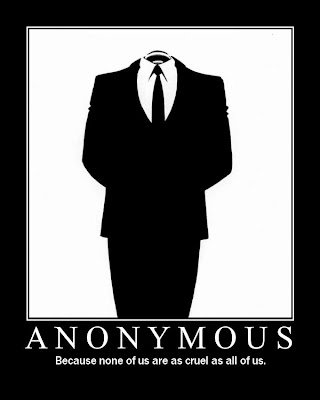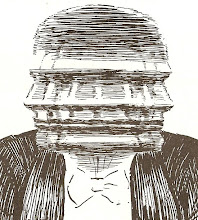Imagine a topic, and there will be a website for it. (This is a corollary of the infamous
Rule 34.) The more popular the topic, the more numerous the websites; with movies as popular as they are, it's no surprise the web teems with movie websites of all kinds.
One of the most popular movie websites is
Ain't It Cool News (AICN), which has been around for more than a decade. Of all the popular sites to survive since dialup days, AICN is rare in that it actually shows its age: minor tweaks aside, the design of the website has
barely changed in ten years. The colour scheme and font choices are so old-fashioned that they've gone past 'daggy' and out the other side; they might now seem simply idiosyncratic, or quaint. But beyond cheesy browns and thick capitals lie more serious design flaws.
AICN's articles are categorised into only a few different sections, but the general organisation is inconsistent and confusing. Following the blue bar which heads every page on the site, articles fall under one of three basic categories:
Reviews, which are reviews by site founder and 'HeadGeek'
Harry Knowles;
Coaxial, which includes all TV-related news and DVD release information; and
Cool News, which is everything else. Under the Cool News category are posted rumours, news, interviews, reviews by people who aren't Knowles (a team of regular contributors, plus anonymous reports), miscellaneous
spoilers (promo images and set reports, both official and leaked), and competitions. The site also posts articles focusing on
comics,
tabletop role-playing games,
cinema in Australia, and
anime. These are categorised as Cool News, too.
AICN's categorisation and structure could easily be improved. Modern websites commonly tag their articles with multiple keywords, which efficiently streamlines organisation and search. AICN does not: its three header categories are all that is. However, the site's actual homepage also lists new articles under a confusingly different set of headings. 'Harry's Reviews' corresponds to the Reviews category, 'Coaxial' is Coaxial, and 'Latest News' includes all new articles that aren't Coaxial (including Reviews). Cool News articles are posted again under more specific headings, too: '
Contests', '
DVDs', '
Comics', and '
Animation'. And there's a 'Top Stories' heading, too, but it's hard to say what classifies any particular story as 'Top'. If all this sounds confusing, that's because it is.
The homepage headings are useful in principle, but they only show the most recent articles. The headings aren't tags, so if you want to search for articles under a particular heading you simply can't; if an article is older than a month or so, you can't find it except in the all-encompassing Cool News archive, or via
Google. It's long been asserted that readers need efficient devices to help them skim pages (
e.g.), and you could argue that AICN's homepage is an adequate way to present constantly-updated information in a skimmable format: it's all headlines, all concise, all large clear type. However, as a sensible archive it fails terribly.
AICN's clumsy design extends to articles, too. Although it's long been asserted that webpages should use '
multiple signs' and include appropriate graphics (
e.g.), a
typical AICN review is a simple block of text. Although relevant images and videos are often embedded in
news or rumour articles, they are almost never included in reviews. And while an article may mention dozens of linkworthy items, there are usually few or no links (aside from the author's email and
Twitter). News and rumour articles will link to their primary sources if possible, but that's about it.
Some designers and theorists are wary of links, worrying that they '
disrupt the flow of content . . . inviting the user to leave your site' and warning web writers to avoid excessive linking. But in general, most recognise that links are a good thing (
e.g.): links are
well-liked by readers and are a
key element of web life. Given this, is AICN's continued success an argument against the modern design principles that it flouts (i.e. links, images, clear organisation)? Or does it simply prove that content is more important than style?
In contrast to AICN, movie website
Cinematical has a far more professional sheen. Cinematical is part of the
Weblogs, Inc. blog network, and it may be this tangible connection to a commercial overlord that motivates its design and architecture. Certainly, Cinematical is more blatantly commercial than AICN: where AICN advertisements are few and unobtrusive, Cinematical employs multiple images in a way that is sometimes distracting. Cinematical also devotes significant space to advertising its blog network partners (although mostly at the bottom of pages, where it is relatively unobtrusive).
Cinematical's most obvious advantage over AICN is its organisation. Articles are tagged by keyword and arranged into logical category headings on the homepage, so they are always easy to find; the inbuilt search bar has multiple options, too. Cinematical's abundance of information and advertisements could easily render the site incomprehensible, and it does look 'busier' than AICN at first. But once actually using the site, it's soon evident that Cinematical is much better for clarity and ease of use.
Compared to AICN, a
typical Cinematical article is also far more web-optimised. Articles consistently provide more links, every post includes at least one image, and there is a reasonable amount of multimedia content. The authorial tone is typically less gonzo and more professional (or 'journalistic') than AICN, but it still reads more like a blog than a newspaper. There are playful articles like '
Our Favorite Montages: Rocky IV' – the kind of fannish geekery that once would have been unthinkable from a serious news outlet, but is the blogosphere's bread and butter.
Cinematical and AICN are both relatively large and comprehensive sites, but many movie websites operate on a smaller scale.
In Film Australia began as a site covering all movies, presumably with ambitions to match the larger sites, but it
recently relaunched to focus wholly on Australian cinema. This is not surprising: there are already plenty of sites covering the world of cinema, and it can be difficult for a new site to compete against the entire Internet. In fact, it's
statistically inevitable that web traffic will cluster around only a few key sites. If a site like AICN is the undisputed king of movie news, why would a reader go anywhere else? What surfer would defy their own bookmark? (This may be the ultimate secret of AICN's continued success, despite its old-fashioned design and confusing architecture.)
With In Film's new focus on Australian cinema, there's an immediate difference to the site. Without any emphasis on breaking Hollywood news and rumours, the tone becomes immediately more sedate and intellectual (or at least, 'not populist'). This may also be a consequence of the Australian focus, given that so many Australian films possess an 'artsy' and quasi-academic (dare one say, 'not populist') feel. The increased prevalence of retrospective articles enhances this mood, too; unlike AICN, there's no sense of immediacy or obsession with what's coming next.
In Film's site follows the same basic blog structure as Cinematical, although simplified. Articles are tagged by keyword, but in In Film's case it's a tagging that seems to miss the point. Reviews are tagged as '
Reviews' and nothing else, but they also include the heading 'Review:' as part of their title. Other categories follow this redundant pattern. And despite this simplicity, I noticed that at least one article had been
wrongly tagged. Nevertheless: it may not be a very sophisticated system of categorisation, but at least it's clear.
A
typical In Film article looks as if it was written with print in mind. There are practically no links in text, although articles do feature occasional multimedia content. Oddly, this apparent focus on text might contribute to In Film presenting a more 'respectable' sheen than Cinematical or AICN. It certainly feels more thoughtful and literate, language-wise; on the other hand, the aura of intellectual respectability may be due to visual cues as much as anything else. Note the sedate earth tones, the comforting slabs of serif text, the moderately-sized type.
In Film's more detached, intellectual tone may be its downfall. Popular blogs usually have a strong personal voice, and it's difficult to feel that coming through at In Film. The question of 'voice' in web writing is a difficult one; as
some have noted, what sounds 'perfectly normal' in a traditional press editorial may sound 'distant and pontifical' when used in a blog. This is especially important because websites, far more so than traditional press, rely on interactions and contributions from their readers to survive.
It is easy to see a correlation between authorial tone and reader participation. The resolutely informal AICN has a
vibrant message board culture, and many AICN articles acquire
hundreds of comments; Cinematical and In Film, more formal and less personal than AICN, average only a few comments per article. It seems obvious that '
an informal and personal style of writing . . . invites interaction and sharing, the most powerful features of the web'. By resisting an overly personal tone, In Film resists audience collaboration; whether intentionally or not, it reinforces a more traditional model of authorial authority.
In an attempt to provoke the 'interaction and sharing' of its readers, most movie news websites straddle a fuzzy divide between 'fan site' and professional news. AICN started out as the former and is resisting a transition to the latter, despite its increasing importance in the media landscape. Cinematical is undeniably commercial, but it still attempts to maintain a fannish sense of enthusiasm and (relative) independence. Meanwhile, In Film attempts another model altogether: the non-commercial niche blog, building an audience through quality and focus. As the web evolves, time will tell which models are most viable. But the promise of the Internet is that viability only matters if you want it to. As long as fans want to talk about movies, there will be plenty of sites to do just that.
REFERENCESAin't It Cool News
Best Movie & Film Websites
Bowles, D. A. and D. L. Borden (2000) 'Editing for the Web' in Creative Editing. Belmont: Wadsworth
Buckmaster, L. The Buck Stops 'ere
Cinematical
Cinetology
Dube, J. (2003) 'Writing news online', Poynter.org
Dark Horizons
DuVergne Smith, N. (2003) 'Thoughts in progress on writing for the web', self-published at AOL
Heron, A. (2008) 'The Most Useful Movie Websites 2.0', FILMdetail
HitFix
In Film Australia
Internet Archive Wayback Machine
Kaplan, N. (2000) 'Literacy Beyond Books' in A. Herman and T. Swiss (eds) The World Wide Web and Contemporary Cultural Theory. New York and London: Routledge
Levine, R. et al. (1999) The Cluetrain Manifesto
Lynch, P. and Horton, S. (2008) Web Style Guide (3rd edition)
Morkes, J. and Nielsen, J. (1998) 'Applying Writing Guidelines to Web Pages', Useit.com
Nielsen, J. (1997) 'Concise, scannable and objective: how to write for the web', Useit.com
Nunberg, G. (2004) 'Blogging in the Global Lunchroom', UC Berkeley School of Information
Pajiba
Shirky, C. (2003) 'Power Laws, Weblogs, and Inequality', Networks, Economics and Culture (mailing list)
Sholin, R. (2009) 'Why we link: A brief rundown of the reasons your news organization needs to tie the Web together', Publishing2.0
Smashing Editorial (2008) '10 Principles Of Effective Web Design', Smashing Magazine
Urban Dictionary
US Department of Health and Human Services (2006) Research-Based Web Design & Usability Guidelines
Variety
Wallace, N. (1999) 'Web Writing for Many Interest Levels', e-gineer.com
Weblogs, Inc.
Wesch, M. (2009) 'Participatory Media Literacy: Why it matters', Digital Ethnography
Wikipedia



